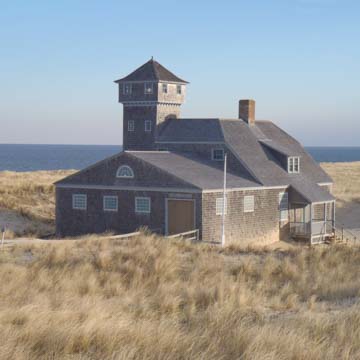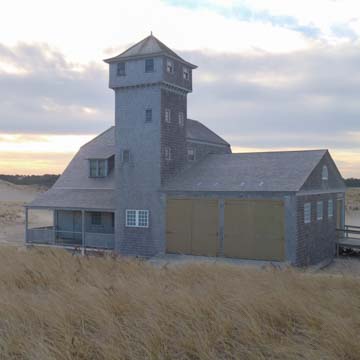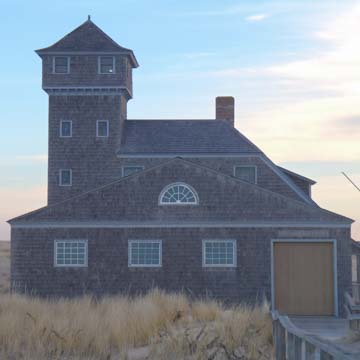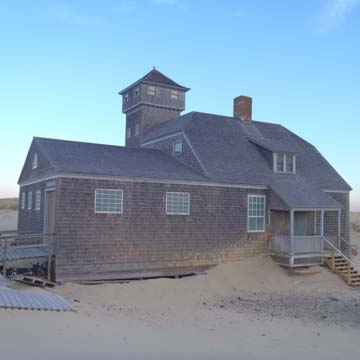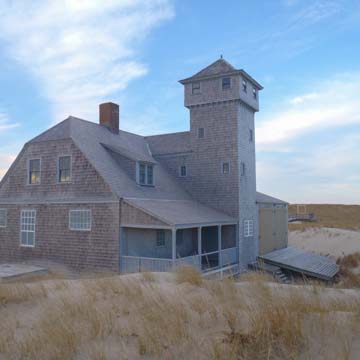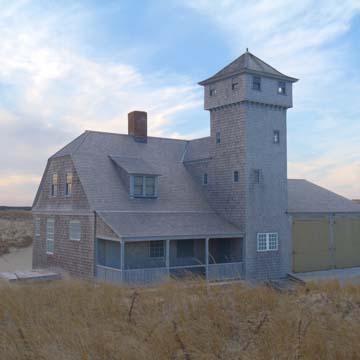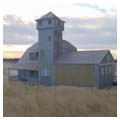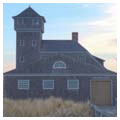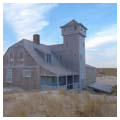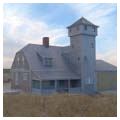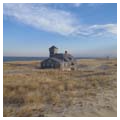Built in 1897, Old Harbor Life-Saving Station stands as one of the most well-preserved examples of a building typology that spread along the American coastline in the late nineteenth and early twentieth centuries. The restored seaside life-saving station, originally located on Nauset Beach in Chatham, Massachusetts, embodies the history of the United States Life-Saving Service (USLSS), the predecessor to the modern Coast Guard.
From 1897 to 1944, when the Coast Guard decommissioned the station, Old Harbor operated within a national network of coastal life-saving stations. The USLSS, which Congress authorized in 1878, had its origins in volunteer-led charitable organizations. In the early nineteenth century, the Massachusetts Humane Society constructed small shacks at the most dangerous points of the coastline and supplied them with food and clothing in the hopes that victims of shipwrecks could reach shore and find succor there. These small huts gave way to lifeboat stations, which housed boats in which volunteer crews could row out to assist shipwrecks. Similar lifeboat stations formed on the New Jersey coastline and, in 1841, Congress appropriated money for construction of several lifeboat stations on the Atlantic and Gulf coasts. Shipwrecks, though, continued to plague American transportation. In 1871, Congress funded full-time crews and financed the design and construction of new stations that surpassed the earlier huts and lifeboat stations both in size and aesthetics.
In 1878, the USLSS became a federal agency under the Department of the Treasury (it had previously been a federally funded service not an official government agency). Over the next three decades, the USLSS built and manned stations all along the U.S. coastlines, including those of the Pacific Ocean and the Great Lakes. Sumner Kimball, the agency’s first General Superintendent (1878–1913), developed a comprehensive set of regulations that established a daily regimen for all stations and standardized rescue procedures. These regulations structured both Old Harbor’s physical form as well as the lived experience of the men employed there. As the number of stations and crews’ training increased, the USLSS became highly effective at assisting near-shore shipwrecks and this was particularly important along the treacherous stretch of Cape Cod’s coast that Old Harbor’s crew safeguarded.
Kimball also centralized the design of life-saving stations, whose construction was overseen by the newly appointed Assistant Superintendent of Construction. Kimball hired architects to produce easily replicated designs. A given design could be found anywhere in the country or a single stretch of coastline might contain a few different designs. Indeed, Old Harbor’s neighbors to the north and south had slightly different styles and plans while stations identical to Old Harbor can be found on the Great Lakes and Pacific Coast. Though designs came from the Washington, D.C., office, individual stations might display some local variations. Furthermore, a few communities hired architects to design local stations.
Life-saving stations like Old Harbor served both practical and symbolic purposes. On a functional level, Old Harbor housed six to seven men full-time for several months (during the more stormy winters) in addition to storing bulky life-saving equipment, including a large lifeboat. An enclosed lookout tower stood atop the stations, including Old Harbor, to allow lifesavers to keep constant watch over shorelines. Sometimes small outbuildings, such as stables or kitchens, surrounded the stations. At the same, stations served as significant symbols of increasing federal power by aligning with the popular architectural styles of the time. Early variants were modest Stick Style and Carpenter Gothic cottage-like buildings, yet in the mid-1880s they began to display the more fashionable Queen Anne and Classical Revival styles. Located in both established seaside communities and remote sections of the American coastline, life-saving stations physically announced the extension of the government’s authority across the entire coastline of the United States.
Old Harbor’s architect, George R. Tolman, served as the third Assistant Superintendent of Construction (1893–1896), and designed the Duluth-type life-saving station (named for its first iteration in Duluth, Minnesota), of which Old Harbor is a representative example. Old Harbor exhibits aspects of the Shingle and Queen Anne styles, but most squarely fell within the rubric of the Classical Revival style. The building is roughly divided into two halves. One side housed the crew’s living quarters, the first floor of which had a kitchen, pantry, mess hall, and an office and room for the keeper, or head of the station. The second floor contained large sleeping quarters for the crew. The other half of the station consisted of a large one-story boat room, which housed the lifeboat and other equipment. A three-story tower rose from the center of the station. Unpainted cedar shingles sheathed the entire building, which had a large, clipped-gable roof. Old Harbor contained few ornamental details other than a single fanlight window and cornice line. In Old Harbor, Tolman created a structure that not only provided ample space for the lifesavers to live and work, but also announced the presence and permanence of the federal government along the nation’s shores.
After the station was decommissioned in 1944, the government sold it, and the private buyer used it as a hunting lodge for many years. In the early 1970s, the government reassumed ownership through the Cape Cod National Seashore, which extended along Cape Cod’s eastern shore. By 1977, the eroding shoreline in Chatham threatened to drown the historic and now rare life-saving station. Accordingly, the National Park Service relocated Old Harbor by barge over thirty miles north to Race Point Beach in Provincetown at the location of a no longer extant life-saving station. Today, Old Harbor sits about two hundred yards from the shoreline surrounded by a dune landscape, just as it did formerly in Chatham. After extensive interior and exterior restoration that lasted over a decade, the building opened as a museum that interprets the history of the USLSS.
References
Albee, Peggy, “Old Harbor Life-Saving Station,” Barnstable County, Massachusetts. Historic Structure Report, 1988. National Park Service, U.S. Department of the Interior, Washington, D.C.
Noble, Dennis. That Others Might Live: The U.S. Life-Saving Service, 1878-1915. Annapolis, MD: The Naval Institute Press, 1994.
Shanks, Ralph, and Wick York. U.S. Life-Saving Service: Heroes, Rescues, and Architecture of the Early Coast Guard. Novato, CA: Costano Books, 1996.














